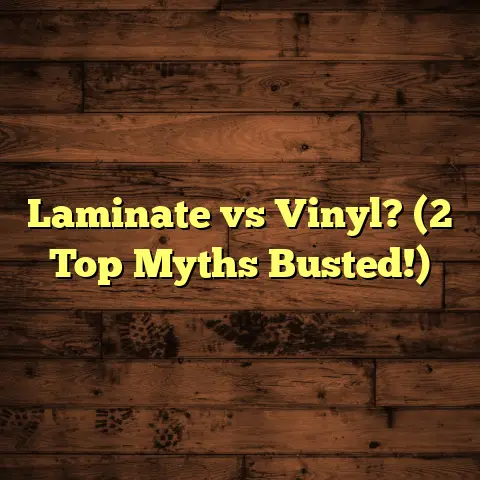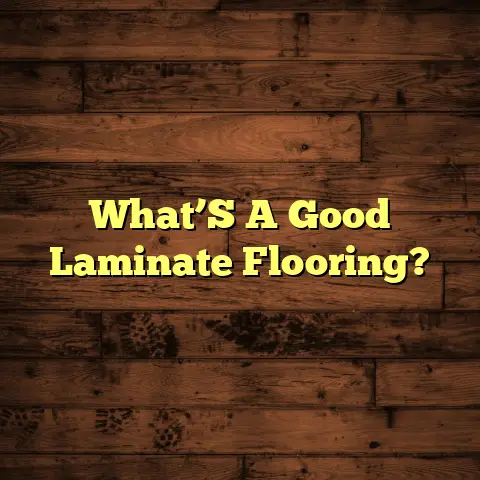Durable Tile For High-Traffic (4 Wear Layer Tips!)
Well, a big part of that secret is the wear layer. And guess what? The flooring industry is also going green, using some pretty cool eco- friendly tech to make these super- durable tiles.
I’m going to break down everything you need to know about wear layers and how to choose the right tile for those busy areas in your life, all while keeping our planet in mind.
Section 1: Understanding High-Traffic Areas
Okay, let’s get real. What exactly is a high-traffic area? In your home, it’s probably the kitchen, hallway, entryway, or maybe even the living room if you have kids or pets (or both!).
Commercially, think retail stores, restaurants, offices – places where people are constantly moving around.
These areas put a serious beating on floors. We’re talking:
- Scratches from shoes and furniture
- Dents from dropped objects
- Fading from sunlight and constant cleaning
Choosing the wrong flooring can lead to a maintenance nightmare and a space that looks worn-out way too soon. Trust me, I’ve seen it all.
And that’s why picking the right flooring material is crucial. It not only affects how long your floor lasts but also the overall look and feel of your space. Plus, a good choice can save you money on repairs and replacements down the road.
Section 2: The Role of the Wear Layer
So, what’s this “wear layer” I keep mentioning? Think of it as the tile’s bodyguard. It’s the top surface that protects the design and the core of the tile from all that wear and tear.
It’s like the clear coat on your car – it takes the brunt of the damage so the paint underneath stays looking fresh.
Wear layers come in different thicknesses, usually measured in mils (thousandths of an inch). The thicker the wear layer, the more durable the tile. Makes sense, right?
Now, let’s talk materials. You’ll find wear layers made from:
- Vinyl: Common in LVT (Luxury Vinyl Tile). Offers good scratch and stain resistance.
- Ceramic: Very durable and water-resistant. Often used in high-traffic areas.
- Porcelain: Even denser and more durable than ceramic. Ideal for heavy use.
Each material has its pros and cons, but they all serve the same purpose: to keep your floors looking good for as long as possible.
Section 3: Tip 1 – Selecting the Right Thickness
Alright, time to get specific. How do you choose the right wear layer thickness? It all depends on how much traffic the area gets.
Here’s a general guideline I use:
- Residential Kitchens/Bathrooms: A wear layer of 12-20 mils is usually sufficient.
- Commercial Retail Spaces: You’ll want something tougher, like 20-30+ mils.
- Office Environments: 12-20 mils can work, but consider 20+ mils for high-traffic areas like reception.
Keep in mind that the thickness affects not only durability but also how comfortable the floor feels underfoot. A thicker wear layer can provide a bit more cushioning, which is especially nice if you’re on your feet all day.
For example, I had a client with a busy retail store. They initially installed tiles with a 12-mil wear layer, and within a year, they were already seeing scratches and wear. We replaced it with a 30-mil option, and they haven’t had any issues since.
Section 4: Tip 2 – Opting for Quality Materials
Don’t skimp on quality! The material of the wear layer is just as important as the thickness.
Let’s compare some popular options:
- Ceramic Tile: A classic choice. Durable, water-resistant, and comes in a wide range of styles. Look for a high PEI (Porcelain Enamel Institute) rating. This rating indicates the tile’s resistance to abrasion. A PEI of 3 or higher is good for moderate to heavy traffic.
- Porcelain Tile: Even tougher than ceramic. It’s denser and less porous, making it ideal for high- traffic areas and wet environments. Also has PEI ratings, so check those.
- LVT (Luxury Vinyl Tile): A popular choice for its versatility and realistic designs. Look for options with a thick wear layer (20+ mils) and a durable core.
When evaluating quality, look for certifications and standards like:
- FloorScore: Ensures that the flooring meets strict indoor air quality standards.
- GreenGuard: Similar to FloorScore, but with a broader focus on chemical emissions.
These certifications give you peace of mind that you’re choosing a product that’s not only durable but also safe for your health.
Section 5: Tip 3 – Maintenance and Care
Even the toughest wear layer needs some TLC. Proper maintenance can significantly extend the lifespan of your flooring.
Here are some tips:
- Regular Cleaning: Sweep or vacuum frequently to remove dirt and grit that can scratch the surface.
- Use the Right Cleaners: Avoid harsh chemicals that can damage the wear layer. Stick to neutral pH cleaners recommended by the tile manufacturer.
- Mats and Rugs: Place mats at entrances to trap dirt and moisture. Use rugs in high-traffic areas to provide extra protection.
- Routine Inspections: Check for cracks, chips, or loose tiles regularly. Address any issues promptly to prevent further damage.
I had a client who complained that their LVT flooring was looking dull and scratched after only a few years. Turns out, they were using abrasive cleaners that were slowly wearing down the wear layer. Once they switched to a pH-neutral cleaner, their floors started looking much better.
Section 6: Tip 4 – Sustainable Choices and Eco-Tech Innovations
Okay, let’s talk about the green stuff! The flooring industry is making huge strides in sustainability, and that includes eco-friendly tile options.
Here are some eco-tech innovations to look for:
- Recycled Content: Tiles made from recycled glass, porcelain, or other materials. This reduces waste and conserves resources.
- Low-VOC Finishes: VOCs (Volatile Organic Compounds) are chemicals that can off-gas and affect indoor air quality. Look for tiles with low-VOC finishes.
- Energy-Efficient Manufacturing: Companies that use energy-efficient processes to reduce their carbon footprint.
Some companies are leading the way in eco-friendly tile production. For example, mention a specific company and link to their website if possible. Example: Florim is known for its commitment to sustainability, using recycled materials and energy-efficient manufacturing processes.
When making sustainable choices, look for:
- Environmental Product Declarations (EPDs): These provide detailed information about the environmental impact of a product.
- Cradle to Cradle Certification: This certification evaluates products based on their material health, material reutilization, renewable energy use, water stewardship, and social fairness.
Choosing eco-friendly tiles not only benefits the environment but can also improve the air quality in your home or business.
Conclusion
Choosing durable tile for high-traffic areas is all about understanding the wear layer and making informed choices. By selecting the right thickness, opting for quality materials, maintaining your floors properly, and considering sustainable options, you can ensure that your floors look great and last for years to come.
And remember, eco-friendly technology is playing a huge role in modern flooring solutions. By choosing sustainable tiles, you can create a beautiful and durable space while also contributing to a healthier planet.
So, next time you’re shopping for flooring, keep these tips in mind. Your feet (and the environment) will thank you!





